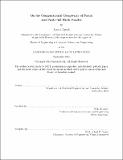On the computational complexity of portal and push-pull block puzzles
Author(s)
Lynch, Jayson (Jayson R.)
DownloadFull printable version (1.227Mb)
Other Contributors
Massachusetts Institute of Technology. Department of Electrical Engineering and Computer Science.
Advisor
Erik Demaine.
Terms of use
Metadata
Show full item recordAbstract
We classify the computational complexity of two types of motion planning problems represented in games. Portal, a popular video game, is shown to be NP-hard or PSPACE-complete depending on the game mechanics allowed. Push-pull block puzzles are games, similar to Sokoban, which involve moving a 'robot' on a square grid with obstacles and blocks that can be pushed or pulled by the robot into adjacent squares. We prove that push-pull block puzzles in 3D and push-pull block puzzles in 2D with thin walls are NP-hard to solve. We also show certain 3D push-pull block puzzles are PSPACE-complete. This work follows in a long line of algorithms and complexity work on similar problems Wil91, DDO00, Hof00, DHH04, DH01, DO92, DHH02, Cul98, DZ96, Rit10]. The 2D push-pull block puzzle also shows up in a number of video games, thus implying other results, further continuing the work on understanding video games as in Vig12, ADGV14, For10, Cor04.
Description
Thesis: M. Eng., Massachusetts Institute of Technology, Department of Electrical Engineering and Computer Science, 2015. This electronic version was submitted by the student author. The certified thesis is available in the Institute Archives and Special Collections. Cataloged from student-submitted PDF version of thesis. Includes bibliographical references (pages 49-53).
Date issued
2015Department
Massachusetts Institute of Technology. Department of Electrical Engineering and Computer SciencePublisher
Massachusetts Institute of Technology
Keywords
Electrical Engineering and Computer Science.